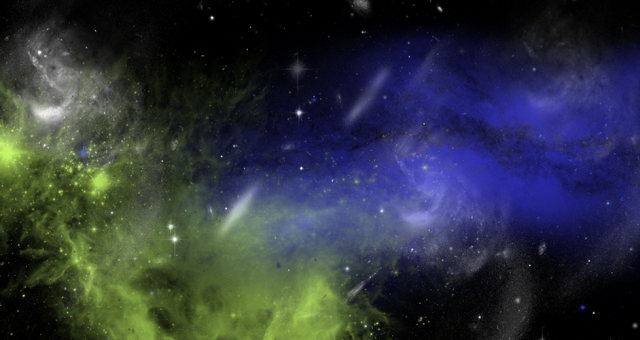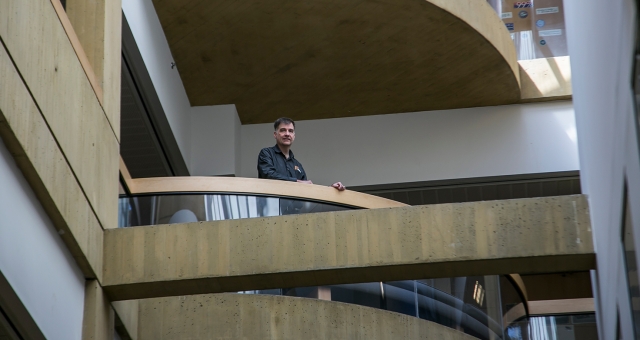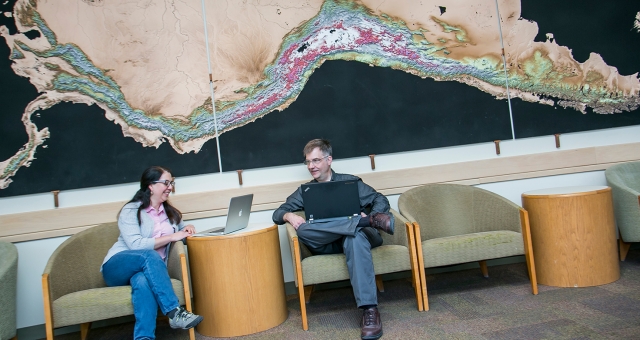High in the Andes Mountains outside Lima, Peru, lies the largest radar in the world—the Jicamarca Radio Observatory, a thousand-foot-by-thousand-foot antenna grid linked to four transmitters that together produce a hefty six megawatts of power. It was the brainchild of a group of innovative scientists from Cornell and was ahead of its time when it was built in 1961 by a forerunner of the National Oceanic and Atmospheric Administration. Today Cornell still has a hand in overseeing it through the guidance of David L. Hysell, Earth and Atmospheric Sciences. Hysell became the primary investigator for the National Science Foundation Cooperative Agreement that supports Jicamarca in 2005.
Using the Jicamarca Radio Observatory
Hysell studies the ionosphere—the upper layer of the Earth’s atmosphere 75–1000 kilometers (46–621 miles) above the Earth. Although it is almost a vacuum, the ionosphere does have some free electrons liberated by solar radiation, along with positive ions. Hysell uses Jicamarca’s powerful radar to monitor and measure this elusive medium.
“We’re detecting the electrons,” Hysell says. “It turns out they are telltale of everything. The ionosphere is a plasma. All the parameters you’d want to measure for any kind of fluid—things like the amount of ionization, what species of ion it is, temperature density, composition, drifts, and so on—we can study by looking at the scatter that comes off the electrons.”
Hysell and his fellow researchers use the data collected by Jicamarca for both theoretical and applied physics research. On the theoretical side is the continuing need to understand plasma physics in general and specifically the mysteries of space weather occurring in the ionosphere where storms are constantly happening. “The ionosphere can very easily be pushed out of its equilibrium resting state,” says Hysell. “It’s much closer to the threshold of instability than the terrestrial atmosphere is. Tornados and hurricanes are rare because terrestrial atmosphere is so stable. Jicamarca has shown us that in the ionosphere something as small as an unusual wind pattern is enough to trigger a geomagnetic storm.” In fact, storms are going on constantly in the ionosphere—some launched by solar activity and some created by the small fluctuations in the prevailing conditions.
Space Weather Forecasting, Geomagnetic Storms, Air Travel, and More
On the practical side, when geomagnetic storms occur in the ionosphere, radio signals behave very strangely, and communications can be disrupted on the Earth. “If you’re trying to pass radio signals through the ionosphere when these storms are pressing, it won’t work,” Hysell explains. “That means GPS, satellite communications, and ground-based communications won’t work.” That can have major implications for the military. It can also adversely affect many companies in the private sector, such as big agriculture companies that use GPS to guide farm equipment and oil companies, which depend on GPS-guided drills for their offshore drilling platforms.
“We’re detecting the electrons,” Hysell says. “It turns out they are telltale of everything. The ionosphere is a plasma.”
Much time, energy, and money are spent trying to compensate for the disruptions caused by geomagnetic storms. When technology is affected, it may not be clear at first whether the disruption is caused by a storm, equipment failure, or purposeful human activity seeking to interfere with communications. “We do have computer systems in place that will tell you in real time whether space storms are underway,” Hysell says. “That can clarify the immediate situation, but it would be really good if we could forecast even a few hours out. Then we could tell people, for example, that this afternoon would not be a good time to fly your drones, or you need to lock down your offshore drilling platform so you don’t break your drill bit.”
Until now, it’s been very difficult to make any sort of prediction about the weather in the ionosphere, but Hysell and his fellow researchers are aiming to change that. “We’re getting to the point where we’ll be able to forecast a few hours in advance very soon,” he says. “We have a big computer model that seems to have the physics right, and it appears to work in test cases.”
One agency that is very interested in Hysell’s work is the Federal Aviation Administration. When geomagnetic storms triggered by the sun occur, the high latitudes are affected, causing airlines to reroute flights to avoid exposing passengers and flight crews to elevated levels of radiation. “That costs a lot of money,” says Hysell. “Inevitably you end up with a longer route and that takes more fuel. Right now airlines will reroute flights when there’s a broad-brush indication of geomagnetic activity. They’re erring on the side of caution, but they’d like a much more reliable indication of exactly when they need to change the routes.”
Windy
Along with his work at Jicamarca, Hysell also has multiple research projects that are space-based. He’s currently in the process of planning a NASA rocket campaign called Windy that will take place in the summer of 2017. The rocket will launch from the Marshall Islands, carrying instruments that will collect data from low-latitude hemispheric storms in the ionosphere. The data will be compared to ground-based data collected by a radar that belongs to the Department of Defense.
“The whole flight will take 10 minutes,” Hysell says. “It’s very precise because you know exactly where the rocket is, and the whole time the instruments are sending out data at hundreds of thousands of samples per second. The ground-based instruments provide context for the rocket data. This allows us to go from notions about what’s happening in the ionosphere to an extremely quantitative view of what’s happening. It’s a way of validating our theories.”
Advanced Small Radars, GPS receivers, and Cell Phones
Hysell also works with other scientists at Cornell to make small radars that can be fielded all over the world to observe phenomena in the ionosphere. Right now there’s a small radar system set up in Homer, Alaska, to look at the Aurora Borealis in the high latitudes and another on the island of St. Croix in the Caribbean to study space weather at the mid-latitudes. “We make these small radars in the lab,” says Hysell. “And they’re really advanced. We’re borrowing from what we’ve learned from the big radars like Jicamarca. We’ve developed a new technique where we can make volumetric images of what’s going on in space. We’re the only group that is doing this in a large way.”
For 50 years Hysell and other researchers have been building on the techniques and discoveries learned from Jicamarca, but the usefulness of the giant radar facility is coming to an end, Hysell says. “Soon, what we’ll have is lots and lots and lots of GPS receivers, and things like that, networked together. It costs $100 million dollars to built a Jicamarca. You can buy a good GPS unit for $500.”
As Hysell sees it, even our cell phones may become scientific instruments linked together into a gigantic network with the power of Jicamarca. “Every phone has a GPS,” he says. “It’s not very good, but it’s something. And if everyone’s cell phone was part of the system and they all were reporting a loss of contact due to ionospheric interruptions, then you could have a great space weather-warning network. It wouldn’t cost anything.”





